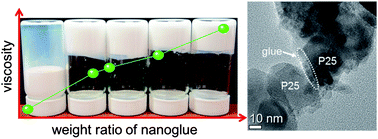An interparticle binding agent, or nanoglue, was synthesized by a sol–gel process, which facilitated the preparation of well-interconnected TiO2 electrodes at low-temperatures for plastic dye-sensitized solar cells. The viscosity of the nanoglue-based pastes was seven times higher than that obtained in pastes without any nanoglue. The increased viscosity was sufficiently high enough for coating thick films to fabricate TiO2 electrodes. The structural and photovoltaic properties of the films were extensively investigated by varying the amounts of nanoglue. A reduced pore size and greatly enhanced surface area were observed in the nanoglue-based films. Improved interparticle connectivity, resulting in faster electron transport, was confirmed by photocurrent transient spectroscopy and electrochemical impedance measurements of the nanoglue-based films. The electron diffusion length and charge collection efficiency were also enhanced in these nanoglue-based films. A maximum conversion efficiency of 5.43% was achieved in films containing 20 wt% nanoglue fabricated on a plastic substrate under one-sun illumination, even without any additional treatment.

You have access to this article
 Please wait while we load your content...
Something went wrong. Try again?
Please wait while we load your content...
Something went wrong. Try again?


 Please wait while we load your content...
Please wait while we load your content...